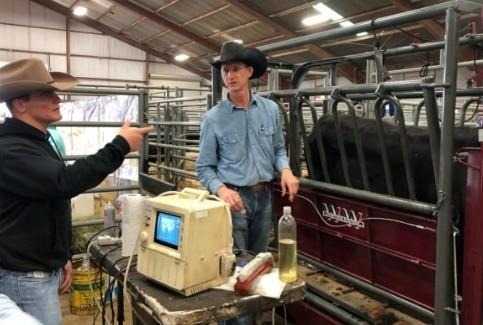By Melanie Greaver Cordova
A new study from the College of Veterinary Medicine explores how willing dairy consumers are to purchase milk made by cows only treated with antibiotics when medically necessary. Too much antibiotic treatment in cows leads to the rise of resistant strains of bacteria, which can make both animal and human antibiotics less effective. The findings suggest that if farmers can find the right price point for this type of milk, then dairy consumer preferences can help slow the rise of antimicrobial resistance.
“Most of the antibiotics produced throughout the world are used for animal agriculture. Therefore, reducing antibiotic use in animals, including dairy cattle, is necessary to tackle antibiotic resistance at a global scale,” said Dr. Renata Ivanek, professor in the Department of Population Medicine and Diagnostic Sciences. Ivanek is senior author on the study, which published Nov. 3 in the Journal of Dairy Science.

“Most of the antibiotics produced throughout the world are used for animal agriculture. Therefore, reducing antibiotic use in animals, including dairy cattle, is necessary to tackle antibiotic resistance at a global scale.” - Dr. Renata Ivanek
In the study, the researchers propose a new label for milk that indicates responsible antibiotic use (RAU), which would leverage consumer preferences to promote practices that reduce the use of antibiotics on commercial dairy farms. The study showed that, although a consumer’s willingness to pay for the RAU-labeled milk was comparable to how much they would pay for the unlabeled milk, their self-reported preference for an RAU-labeled milk was high versus the unlabeled milk option. Therefore, the researchers posit that this new RAU label would entice farmers to minimize antibiotics more than conventional, unlabeled milk.
“Consumers should know that their choices are important, and that their understanding of antibiotic use could move the dairy industry toward more sustainable milk production practices,” said Dr. Ece Bulut, research associate in the Department of Population Medicine and Diagnostic Sciences, and co-author of the study.
For the study, the researchers conducted a nationally representative survey of U.S. adults, finding that half were willing to buy RAU-labeled milk. They also held a randomized, non-hypothetical experimental auction with real money and milk, which showed that auction participants were also willing to pay for RAU-labeled milk but only slightly more than they are willing to pay for the unlabeled cartons.
“What this means is that there could potentially be a large market for RAU milk as long as the price isn’t much higher than conventional milk, so it’s a possible new option for conventional farmers,” said Robert Schell, M.S. ’19, first author of the study.
“A similar label for certified responsible antibiotic use (CRAU) is already used in the poultry industry,” Bulut said. CRAU limits the use of medically important antibiotics — antibiotics used in human medicine — in poultry production. The researchers envision that the RAU label would similarly be determined by veterinarians and USDA standards, so that any carton of milk with an RAU label would come from a cow only treated with antibiotics when medically necessary.
“The existing literature suggests that larger bodies regulating these sorts of claims, like the USDA and CRAU certification, makes consumers more willing to trust and, as a result, buy products with desirable labels,” said Schell, who is an alumnus of the Charles H. Dyson School of Applied Economics and Management, where he first started working on this study. He is now a Ph.D. student at the School of Public Health in University of California at Berkeley.
This study is an important initial step in exploring consumer attitudes toward an RAU label and its potential market for conventional farmers. The researchers plan to expand their survey to a larger swath of the U.S. population and further investigate the difference between a consumer’s hypothetical willingness to purchase RAU-labeled milk and their decisions when faced with price points in an actual auction. It will also be necessary to determine whether the savings from reduced antibiotic use, combined with any increase in advertising the new label, would offset or surpass the potential increase in the cost of production.
“Overall, the consumer- and farm-level research directions would help identify our options for a sustained market and financially viable mode of milk production that could have transformative implications for the dairy industry and public health,” Ivanek said.
This multidisciplinary study is a collaboration between the College of Veterinary Medicine, the Charles H. Dyson School of Applied Economics and Management, and the Department of Communication. The researchers worked with Cornell’s Lab for Experimental Economics and Decision Research as well as Cornell’s Survey Research Institute. Funding for this study was provided by the National Institute of Food and Agriculture, the U.S. Department of Agriculture and the National Institutes of Health.
Source : cornell.edu